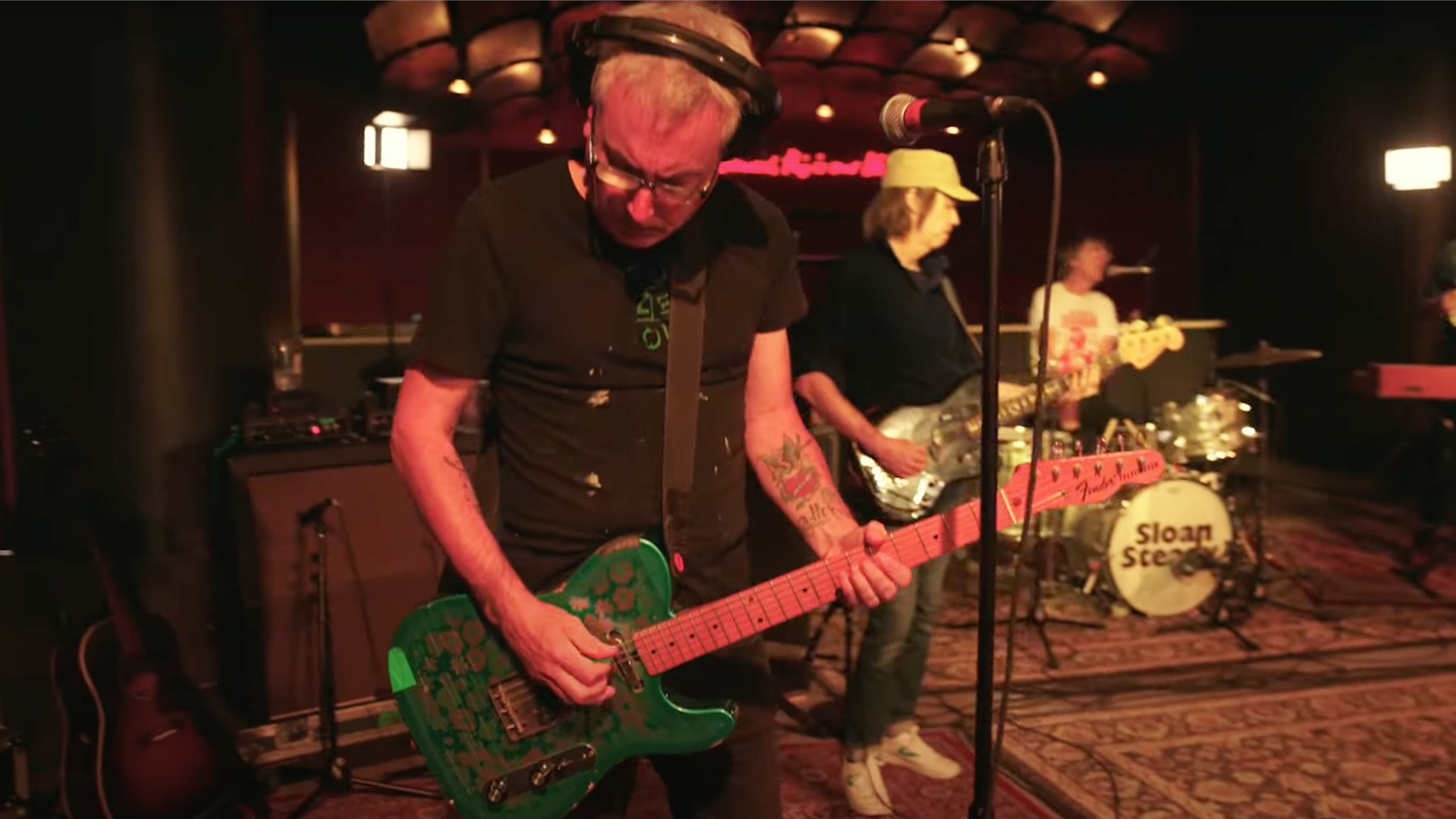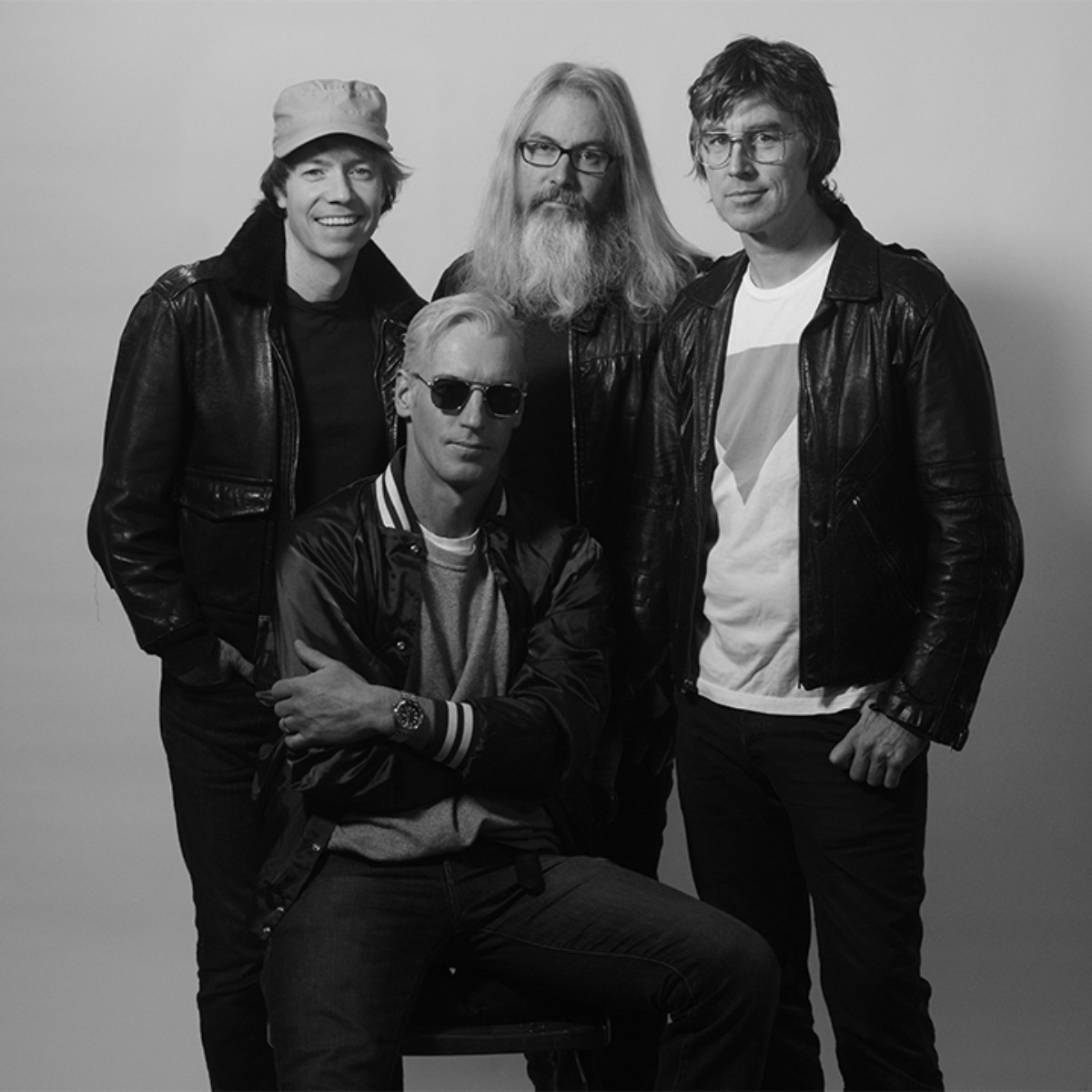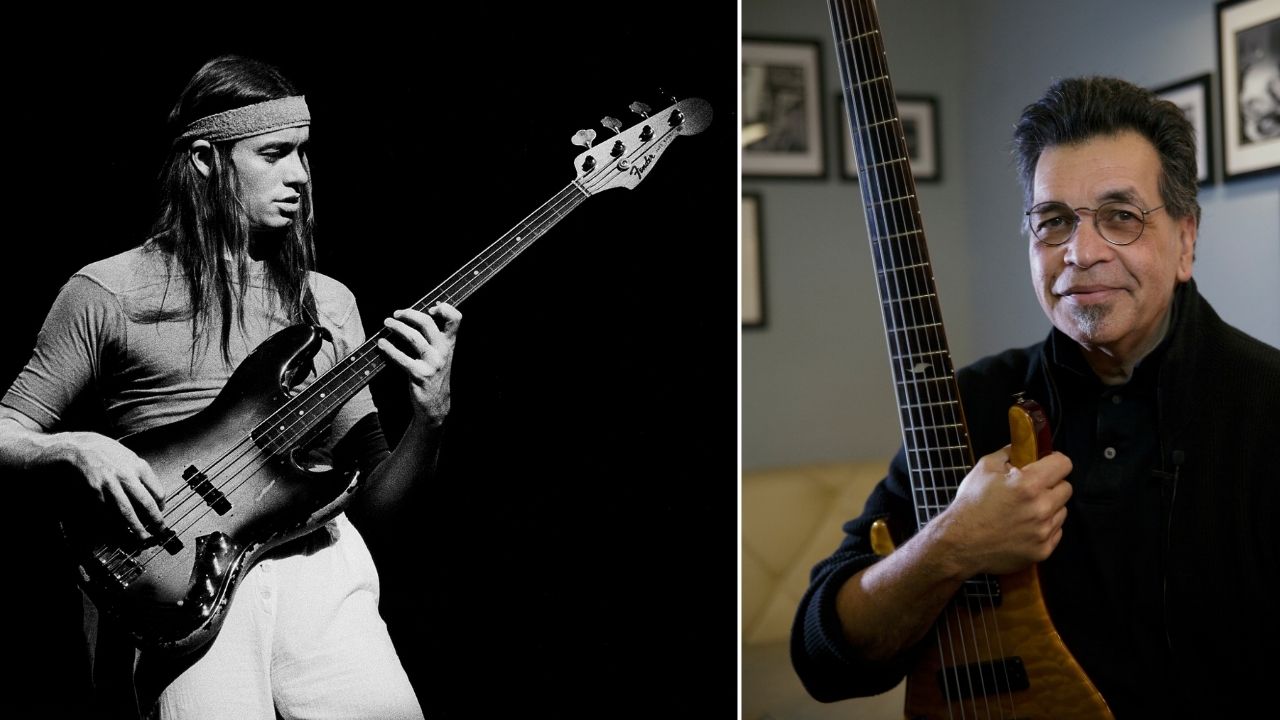Sloan’s Patrick Pentland on the art of democratic songwriting, channeling Ace Frehley through a 5150 and why he prefers a wah that looks like a car to a Cry Baby
The Toronto rock outfit's lead guitarist talks gear secrets, the origins of some of their biggest tracks and their expansive new album, Steady

Steady, the title of Canadian rock veterans Sloan’s recently released 13th album, nods to the inherent stability a group accumulates over 30 years of activity. Then again, when it comes to the songs the Toronto-by-way-of-Halifax quartet have crafted since the early ‘90s, it’s fair to say that kind of steadiness hasn’t limited the band’s ability to explore whatever they please.
From the ear-bleeding shoegaze of their 1992 debut album Smeared, to the Beatles-like about-face of follow-up release Twice Removed, to Angus Young-inspired riffage, pastel-pink twee, and even touches of speed-forward hardcore, Sloan have kept their spectrum wide.
What has, however, stayed pretty consistent since 1999’s Between the Bridges is that Sloan divvy the songwriting duties equally between the core of guitarists Jay Ferguson and Patrick Pentland, bassist Chris Murphy, and drummer Andrew Scott. And, for that matter, if you wrote the song, you’re probably singing and playing guitar on that piece, too.
Steady keeps up the tradition, with Pentland cranking off unhinged wah solos on Scratch the Surface and Spend the Day (though he also adds a sweetly strummed acoustic ballad, Simply Leaving); Ferguson going ‘70s power-pop with light-gain glee (Dream It All Over Again); Murphy’s Nice Work If You Can Get It hitting the Beatles influence like a Rubber Soul deep cut; and Scott’s forte remaining a deceptively easy-breezin’ jamminess (Close Encounters).
As the band’s rawest riffer-in-residence, Patrick Pentland takes Guitar World through the writing of Steady, the moment he realized he could solo on a Sloan song, and the classic car responsible for the new record’s most spectacularly unstable sounds.
There are four distinct songwriters in Sloan, with each of you playing guitar on your respective pieces. Is it fair to say that your songs, in particular, are generally the more rock or lead-oriented pieces on the records?
“On all of our records, yeah. That’s sort of my thing. I’m not sure if you’re aware, but there are a couple of Beatles fans in the band. I can play sevenths like anybody else, but I’m not necessarily that guy.
All the latest guitar news, interviews, lessons, reviews, deals and more, direct to your inbox!
“Power-pop is what we’ve been tagged with, and that, by definition, has to include a sort of late ‘60s, early ‘70s rock aesthetic to it. But if you’re aware of Money City Maniacs, [off 1998’s Navy Blues] there’s an AC/DC feel to it. A hard rock feel, as opposed to the Beatles-y, British Invasion type things.
“One of the things that people tend to do with us is they play the ‘spot the influence’ thing, which tends to be more about the journalist than the musician. ‘Oh, that sounds like that Snakefinger B-side.’ It’s like, ‘I don’t know who the fuck you’re talking about. That’s me!’ I’ve been doing this for 30 years; I know how to play guitar and write songs without constantly being influenced by other people.”
So, you’re saying there’s no Residents/Snakefinger slipperiness going on in your style?
“I point that [guitarist] out because I don’t really know much [about him]. As a kid, I didn’t have a huge record collection because I didn’t have a lot of money. But I did have a library card. I’d check out records, and books of album covers. Snakefinger was in one of them, so I always bring that up. What an insanely weird name.”
I’ve had to learn my solos to play them live… though I tend to just ad lib, regardless
How would you describe the approaches the other members of Sloan take to guitar?
“Chris is pretty meat-and-potatoes. I don’t think he’s sitting at home practicing guitar, but he can play.
“Andrew [has] more of a post-punk, deconstructionist [approach]. His chord progressions and voicings are always a pain in the ass; they’re always odd. His basslines are amazing, but Jay has to learn all of Andrew’s bizarre basslines. If you break Andrew’s songs down, they’re very simple songs, but he has a different feel. Andrew is perhaps the most musical [of us].
“And then Jay tends to be a bit more like Chris in terms of songwriting – a lot of minor sevenths – but Jay is not a big fan of distortion or overdrive. He tends to be cleaner, whereas I’m the opposite. In some ways, that works well.
“I just had a conversation with our soundperson, and they were criticizing me because I was changing my guitar sound as we were playing the show. They were like, ‘Don’t use your neck pickup, and don’t make it less distorted, because I have it mixed in such a way that your distortion complements his cleans.’”
The first two singles from Steady, Scratch the Surface and Spend the Day, are both Patrick songs. Solos abound! What can you say about Spend the Day, which hinges around this chunky-but- glammy, staccato, descending rock riff?
“Well, it’s just a walkdown, really. A to G to D, with an F# to E. But then I have this higher thing in there too. It’s funny, we recorded it with [producer] Ryan Haslett, and Haslett is a big fan of the Clash – who are another band I’m not into. I felt that the higher guitar line that I play is very London Calling; a bit of a Clash feel to it. Punky.
“The solos for that song and Scratch the Surface are both insane. I mean, I played them, but there are a bunch of different parts being put together. Haslett was like, ‘Check out the solo,’ and it was five takes [comped] together.
“I’ve had to learn my solos to play them live…[though] I tend to just ad lib, regardless. I used a Danelectro Dan-O-Wah pedal – it looks like a classic car. I got it on eBay for $30, and it’s the best wah I’ve ever heard in my life. It’s a wah pedal, but it’s also super fuzz-like, [and] it’s got an octave. Usual shit, but for whatever reason it sounds amazing – like [The Jesus and Mary Chain’s] Psychocandy, which was a big record for me.”
Since you mentioned Money City Maniacs, which features another solo of yours that’s steeped in wah, can you recall what you’d been craning through that? Is the pedal still in rotation?
“That was probably just a regular Cry Baby. I don’t know if it was mine, but I assume it was. What had happened was I wanted a wah pedal. We were on tour for our third record, [1996’s] One Chord to Another, and we were in San Diego playing with Redd Kross.
“I went into a pawn shop and there was a Cry Baby for $50, so I bought it. I used it a lot through the rest of the tour, and my bandmates were furious. They didn’t want that wah – but Jay used to use a wah pedal all the time in the band he was in before Sloan.
“For If It Feels Good Do It, the single that I did off [2001’s Pretty Together], the beginning of the song has a bunch of wah noise, because the pedal was broken at that point. I have about four or five [wahs]. The pedal I use [live] is a Cry Baby, but as soon as you touch it, it’s on. That’s really good if you’re a singer who also plays lead, like me. It’s a pain in the ass to turn off a wah.”
What you’re doing lead-wise these days wasn’t really present on anything like Smeared, which was more like a shoegaze record, or through the quieter feel of the next album, Twice Removed. Since you brought up One Chord to Another, I’m wondering about that soaring, but simple three-bend solo on its opener, The Good in Everyone. How pivotal of a moment was that for your lead style?
“That was a weird one. We recorded that solo in Halifax at the studio we were in [Idea of East Recording Studio], and the guy who ran it, Laurence Currie, had a 5150 head and a Les Paul there. [The other Sloan members] were like, ‘This is insanity…how can you plug into a 5150 head and play this.’
“It was so loud; if you just touched the string, it would feed back. It was great! I did the solo, and then I doubled it. That’s the key, the doubling. Not every solo since then has been doubled, but a lot of them have been. That’s a Randy Rhoads thing, or whatever – a classic rock thing.
“There’s a whole story here. Smeared and Twice Removed are difficult records, if you take them together, because they’re completely different [sounding] records; completely different bands, almost.
“When we got to One Chord, we had actually split up [for a brief time]. And when we split up, I was like, ‘Fuck… I’m not pretending to be in the Beatles, or My Bloody Valentine [anymore]; I’m just going to play the way I play.’ So, I did! One Chord is where I started playing real leads.
“Smeared… I wouldn’t say it’s all me, but it’s [got] a lot of my influence [on it]. We [didn’t sound] like that prior to recording that record. I switched from bass to guitar when we were making that record, and suddenly it got a lot louder and distorted. It wasn’t haphazard; I’d been doing that prior to being in Sloan.
You don’t have to be a fan of a band to understand the value and touchstones of what they do. When I grew up, I was a fan of Angus Young, who is a very bluesy player. I don’t have a lot of blues in me, but I can play
“But I sort of shed all that [gear] by the time we got to One Chord. The irony is the next record is probably going to be a Smeared reissue, so I’ll have to play all that noise live. It’ll be good; I have the wah pedals for it.”
Not to belabour the point on that The Good In Everyone solo – and I know you started the conversation by saying you’re not a fan of the journalist telling you where the inspiration lays – but that solo has almost an Ace Frehley spirit to its bends.
“100 percent. But it’s not just that. The breadth of the [vibrato]… Ace does a really wide [vibrato], if you know what I mean. That’s what I did with The Good in Everyone, the joke being that I’m not a Kiss fan either, but Chris is. I was sort of doing an Ace, and he was like, ‘What are you doing?’ I think it was just because of the [5150].
“You don’t have to be a fan of a band to understand the value and touchstones of what they do. When I grew up, I was a fan of Angus Young, who is a very bluesy player. I don’t have a lot of blues in me, but I can play.
“I was really into all that AC/DC riffage when I was younger, and I was also really into Public Image – Keith Levene, who just died recently, was a big influence on us, as well as on Sonic Youth and My Bloody Valentine, who were also big influences on us.
“We were in high school when heavy metal became really popular [in the ‘80s]. Like, Metallica was the be-all end-all, certainly in Nova Scotia. I listened to that because it was guitar music, but I wasn’t big on the imagery. At the same time, while I was listening to Powerslave, there was Psychocandy. I’m just into exciting music.”

Can we get into some of the gear on Steady?
“I used Haslett’s equipment, except for some rhythm guitar I did at home. How it usually works is I start recording demos at home, and just move them from Logic [Pro X] to ProTools at the studio. Most of the rhythm guitars I did by myself would have been with a Fernandes or a Hagstrom Swede.
“I don’t use any of my live gear in the studio, mainly because I’m too lazy to bring it to the studio. And I often don’t know where it is! I have a flower Tele that’s one of the most important things in my life, next to my kids, but I don’t know where it is.
“Haslett has tons of gear. Mainly I used a Les Paul Junior, but I also used a ’64 Gibson SG Junior, a ’64 Gibson Melody Maker, a ’64 Gibson ES-330, and Jay’s Tele thinline.
“Chris has a [Fender] Deluxe Reverb – not sure what year it is, but it’s old. I used that for 90 percent of the rhythm tracks, for sure, and probably leads too.
“But I’m not opposed to going direct and using a plugin. Whatever sounds good, and whatever’s convenient. We also used this really good Mesa/Boogie 112 combo, and a Supro Bantam for leads. I like the boxiness of a combo, as opposed to a big cabinet.
“I love using other people’s stuff, I don’t want to use my own stuff… except for the Danelectro wah!”
The last few Sloan records, I’ve been trying to force in a bit of Smeared, like loud guitar stuff, [but] realized it might not be what everybody else wants to hear
With the lead on Steady’s Scratch the Surface, the signal sounds like it’s being ripped apart. Other than the Dan-O-Wah, what’s going on there?
“It’s the wah pedal with the octave, but we also used a [Eventide] H3000 harmonizer plug-in. So, it’s doubled, but fake doubled. I’ve since deduced that the plugin is listening to the octave, and it can’t decide which note it’s supposed to double.
“So, you get this weird screaming droid sound on that solo – this weird dissonance that is completely out of my control. It’s happening between the different effects. They’re reading each other, and not getting it right… or they’re working great, depending on how you look at it.”
How has debuting your Fuzzed Out project impacted the songs you bring to Sloan? Is it easy to decide what goes where?
“Yes. The last few Sloan records, I’ve been trying to force in a bit of Smeared, like loud guitar stuff, [but] realized it might not be what everybody else wants to hear. In the past, I’d have a song like Take It Easy or Burn for It [where I wouldn’t] know if they’d fit on a Sloan record – maybe they were like square pegs in round holes, or something.
“Then I just decided ‘Fuck it, get a whole different band and do it through that, so you can be more Sloan in Sloan.’ But we made this record [Steady] and I feel like I did the same thing I do, anyways.
“I don’t know if the Fuzzed Out stuff is supposed to be my best [material]; it’s just to get your guitar yeah-yeahs out. There’ll be more Fuzzed Out stuff – I have a whole record of stuff kinda-recorded – and hopefully we’ll start to do shows.”

This is going back to Sloan’s last album, [2018’s] 12, but at least one of your contributions, The Day Will Be Mine, was a song you’d started writing in the ‘90s – Sloan obsessives would recognize it as the Just One Shot demo on the deluxe Navy Blues box set. Was there a similar process at play for your songs on Steady, or are these fresh jams?
“Spend the Day was new. I mean, it’s not that complicated; I came up with it on the spot, almost. Scratch the Surface and [my] other one, Simply Leaving, had kind of been around since we’d been making Action Pact in LA [in 2003] – the chord progression for Simply Leaving was in a faster tempo.
“But we’d already tracked [the album]; we were probably mixing Action Pact. It was like, ‘Fuck… why didn’t we track this?’
“Once you’ve tracked, you shouldn’t touch a guitar for six months, because [otherwise] you’ll come up with the best song you’ve written as you’re mixing the album. I mean, a band like U2 would hold up everything and go make With or Without You, or something, but we didn’t have that option.
Ideas are ideas. It doesn’t matter to me when you came up with them; it matters when you record them
“With The Day Will Be Mine, I remember starting to write that song in Halifax [ed. the band fully migrated to Toronto by the early ‘00s]. With Ill Placed Trust, another song of mine, we were performing that live when we were touring our first record, and then I completely rewrote it and put it on [2006’s] Never Hear the End of It. That was like 15 years later, but ideas are ideas. It doesn’t matter to me when you came up with them; it matters when you record them.”
You’d hinted at Smeared getting a deluxe box set reissue, something Sloan had done before for Twice Removed, One Chord to Another, and Navy Blues. How much music is in the archive for that kind of a release?
“There are a lot of demos, which might show the quick change that took place, musically. I feel like our demos were probably a lot more like the way One Chord to Another sounded than what Smeared ultimately became.
“The other thing is that there’s tons of video footage of us touring Smeared all over Europe and North America, and of us making the record. Chris was documenting lots of stuff with whatever bulky video camera he had. Hopefully that will be an aspect to it.”
- Sloan's new album, Steady, is out now via Murderecords.
Gregory Adams is a Vancouver-based arts reporter. From metal legends to emerging pop icons to the best of the basement circuit, he’s interviewed musicians across countless genres for nearly two decades, most recently with Guitar World, Bass Player, Revolver, and more – as well as through his independent newsletter, Gut Feeling. This all still blows his mind. He’s a guitar player, generally bouncing hardcore riffs off his ’52 Tele reissue and a dinged-up SG.

